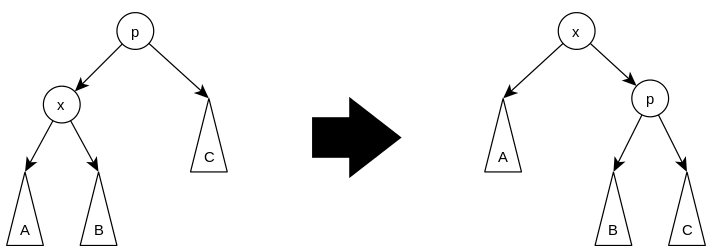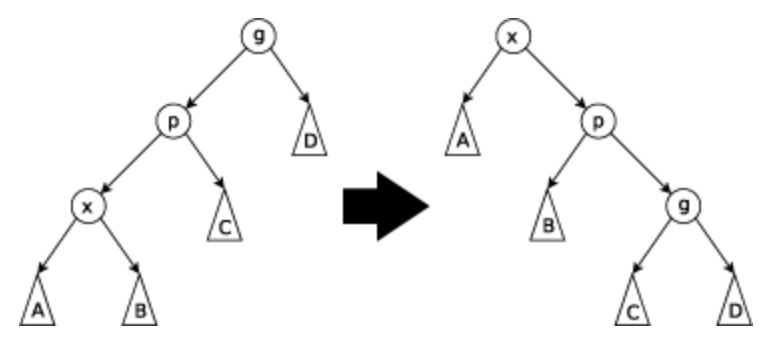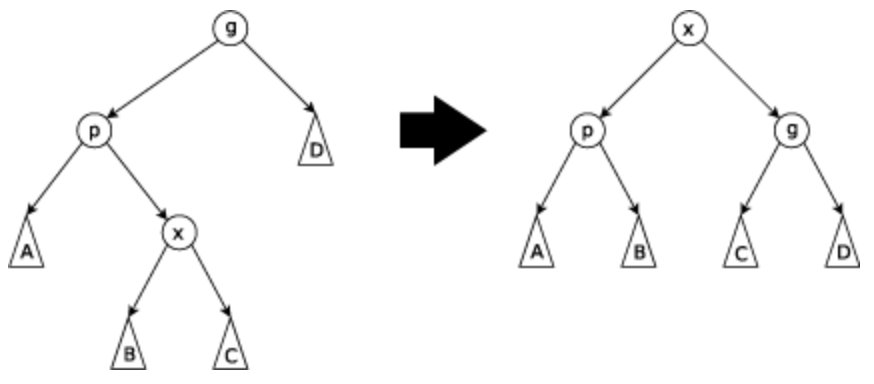AVL, Splay and Amortized Analysis¶
AVL Trees¶
维持平衡的二叉搜索树,每个节点的左右子树高度差不超过1。
高度平衡
定义空树的高度为 -1
- 空树是高度平衡的
-
一个节点是高度平衡的,当且仅当:
- 它的左右子树都是高度平衡的
- 它的左右子树的高度差不超过 1
平衡因子(Balance Factor)
对于一个节点,它的平衡因子是它的左子树的高度减去右子树的高度。
即 \( \text{BF}(v) = \text{height}(T_l) - \text{height}(T_r) \)
Operations¶
树旋转(Tree Rotation)¶

树旋转分为左旋和右旋。旋转操作后,被旋转的边的两端一端的子树高度减小 1,另一端的子树高度增加 1。
参考代码(避免分类讨论):
/*
* type = 0: right rotate
* type = 1: left rotate
*/
Node *rotate(Node *p, int type) {
Node *q = p->child[type];
p->child[type] = q->child[type ^ 1];
q->child[type ^ 1] = p;
maintain_info(p);
maintain_info(q);
return q;
}
Rebalance¶
插入和删除操作后,可能会破坏 AVL 树的平衡性。此时需要进行树的旋转操作,使得树重新平衡。
从插入或删除的节点开始,向上回溯更新平衡因子,直到找到第一个不平衡的节点 X。设 X 中高度更高的儿子为 Z,存在四种情况:
- LL:Z 是 X 的左儿子,且 \( \text{BF}(Z) > 1 \)
- LR:Z 是 X 的左儿子,且 \( \text{BF}(Z) < -1 \)
- RR:Z 是 X 的右儿子,且 \( \text{BF}(Z) < -1 \)
- RL:Z 是 X 的右儿子,且 \( \text{BF}(Z) > 1 \)
这里的命名根据的是失衡的来源,而不是旋转操作的顺序
对应的选择操作:
- LL:右旋 X
- LR:左旋 Z,右旋 X
- RR:左旋 X
- RL:右旋 Z,左旋 X
参考代码:
Node *maintain(Node *p) {
if (p == NULL) return p;
maintain_info(p);
if (p->bfactor > 1) {
if (getHeight(p->child[0]->child[0]) >= getHeight(p->child[0]->child[1])) {
// LL Rotate
return rotate(p, 0);
} else {
// LR Rotate
p->child[0] = rotate(p->child[0], 1);
return rotate(p, 0);
}
} else if (p->bfactor < -1) {
if (getHeight(p->child[1]->child[1]) >= getHeight(p->child[1]->child[0])) {
// RR Rotate
return rotate(p, 1);
} else {
// RL Rotate
p->child[1] = rotate(p->child[1], 0);
return rotate(p, 1);
}
}
return p;
}
Insertion¶
先递归找到插入的位置,新建节点,然后回溯更新平衡因子,直到找到第一个不平衡的节点,然后进行 rebalance。
Deletion¶
先递归找到删除的位置,分类讨论:
- 删除的节点只有小于两个儿子:用子节点替换该节点,从此节点开始回溯更新平衡因子。
- 删除的节点有两个儿子:找到该节点的前驱,交换两节点,随后删除前驱节点,从前驱节点开始回溯更新平衡因子。
复杂度分析¶
设 \( f(h) \) 为高度为 \( h \) 的 AVL 树的最小节点数,那么有:
Fibonacci 数列
Fibonacci 数列的定义为 \( F(0) = 0, F(1) = 1, F(n) = F(n-1) + F(n-2) \)。
其通项公式为:
易得 \( f(h) = F(h+3) - 1 \approx \frac{1}{\sqrt{5}} \left( \frac{1 + \sqrt{5}}{2} \right)^{h+3} - 1\)。
则有 \( h = O(\log n) \),则 AVL 单次操作的时间复杂度为 \( O(\log n) \)。
参考代码¶
luoguP3369 【模板】普通平衡树
#include <stdio.h>
#include <stdlib.h>
#include <string.h>
#include <limits.h>
#define INF INT_MAX
#define max(a, b) ((a) > (b) ? (a) : (b))
typedef struct Node Node;
struct Node {
int key, height, size, bfactor;
Node *child[2]; // child[0]: left child, child[1]: right child
};
typedef struct AVLTree AVLTree;
struct AVLTree {
Node *root;
};
Node *newNode(int key) {
Node *p = (Node *)malloc(sizeof(Node));
p->key = key;
p->child[0] = p->child[1] = NULL;
p->height = 0;
p->bfactor = 0;
p->size = 1;
return p;
}
int getHeight(Node *p) {
return p == NULL ? -1 : p->height;
}
int getSize(Node *p) {
return p == NULL ? 0 : p->size;
}
void maintain_info(Node *p) {
if (p == NULL) return;
p->height = max(getHeight(p->child[0]), getHeight(p->child[1])) + 1;
p->bfactor = getHeight(p->child[0]) - getHeight(p->child[1]);
p->size = 1 + getSize(p->child[0]) + getSize(p->child[1]);
}
/*
* type = 0: right rotate
* type = 1: left rotate
*/
Node *rotate(Node *p, int type) {
Node *q = p->child[type];
p->child[type] = q->child[type ^ 1];
q->child[type ^ 1] = p;
maintain_info(p);
maintain_info(q);
return q;
}
Node *maintain(Node *p) {
if (p == NULL) return p;
maintain_info(p);
if (p->bfactor > 1) {
if (getHeight(p->child[0]->child[0]) >= getHeight(p->child[0]->child[1])) {
// LL Rotate
return rotate(p, 0);
} else {
// LR Rotate
p->child[0] = rotate(p->child[0], 1);
return rotate(p, 0);
}
} else if (p->bfactor < -1) {
if (getHeight(p->child[1]->child[1]) >= getHeight(p->child[1]->child[0])) {
// RR Rotate
return rotate(p, 1);
} else {
// RL Rotate
p->child[1] = rotate(p->child[1], 0);
return rotate(p, 1);
}
}
return p;
}
Node *insert(Node *p, int key) {
if (p == NULL) return newNode(key);
if (key <= p->key) {
p->child[0] = insert(p->child[0], key);
} else {
p->child[1] = insert(p->child[1], key);
}
return maintain(p);
}
Node *erase_max(Node *p) {
if (p == NULL) return p;
if (p->child[1] == NULL) {
Node *q = p->child[0];
free(p);
return q;
} else {
p->child[1] = erase_max(p->child[1]);
return maintain(p);
}
}
Node *erase(Node *p, int key) {
if (p == NULL) return p;
if (key < p->key) {
p->child[0] = erase(p->child[0], key);
} else if (key > p->key) {
p->child[1] = erase(p->child[1], key);
} else {
if (p->child[0] == NULL || p->child[1] == NULL) {
Node *q = p->child[0] ? p->child[0] : p->child[1];
free(p);
return q;
} else {
Node *q = p->child[0];
while (q->child[1]) q = q->child[1];
p->key = q->key;
p->child[0] = erase_max(p->child[0]);
}
}
return maintain(p);
}
int query_rank(Node *p, int key) {
if (p == NULL) return 0;
if (key <= p->key) {
return query_rank(p->child[0], key);
} else {
return getSize(p->child[0]) + 1 + query_rank(p->child[1], key);
}
}
int query_kth(Node *p, int k) {
if (p == NULL) return INF;
if (k <= getSize(p->child[0])) {
return query_kth(p->child[0], k);
} else if (k == getSize(p->child[0]) + 1) {
return p->key;
} else {
return query_kth(p->child[1], k - getSize(p->child[0]) - 1);
}
}
int query_pre(Node *p, int key) {
if (p == NULL) return INF;
if (key <= p->key) {
return query_pre(p->child[0], key);
} else {
int res = query_pre(p->child[1], key);
return res == INF ? p->key : res;
}
}
int query_suc(Node *p, int key) {
if (p == NULL) return INF;
if (key >= p->key) {
return query_suc(p->child[1], key);
} else {
int res = query_suc(p->child[0], key);
return res == INF ? p->key : res;
}
}
void fprint_tree(Node *p) {
if (p == NULL) return;
fprint_tree(p->child[0]);
fprintf(stderr, "%d ", p->key);
fprint_tree(p->child[1]);
}
void free_tree(Node *p) {
if (p == NULL) return;
free_tree(p->child[0]);
free_tree(p->child[1]);
free(p);
}
int main() {
int n;
scanf("%d", &n);
AVLTree *avl = (AVLTree *)malloc(sizeof(AVLTree));
avl->root = NULL;
while (n--) {
int opt, x;
scanf("%d%d", &opt, &x);
switch (opt) {
case 1:
avl->root = insert(avl->root, x);
break;
case 2:
avl->root = erase(avl->root, x);
break;
case 3:
printf("%d\n", query_rank(avl->root, x) + 1);
break;
case 4:
printf("%d\n", query_kth(avl->root, x));
break;
case 5:
printf("%d\n", query_pre(avl->root, x));
break;
case 6:
printf("%d\n", query_suc(avl->root, x));
break;
}
// fprintf(stderr, "[");
// fprint_tree(avl->root);
// fprintf(stderr, "]\n");
}
free_tree(avl->root);
return 0;
}
Splay Trees¶
自调整二叉搜索树,通过 splay 操作保证复杂度。
Splay 树不一定平衡
Operations¶
树旋转(Tree Rotation)¶
Splay 树的旋转操作与 AVL 树类似,还需要额外维护 parent 指针。
参考代码:
// 将 p 向上旋转
void rotate(Node *p) {
if (p->parent == NULL) return;
Node *p_parent = p->parent;
int type = getPosition(p); // 0: left rotate, 1: right rotate
p_parent->child[type] = p->child[type ^ 1];
p->child[type ^ 1] = p_parent;
if (p_parent->parent != NULL) {
p_parent->parent->child[getPosition(p_parent)] = p;
}
p->parent = p_parent->parent;
p_parent->parent = p;
if (p_parent->child[type]) {
p_parent->child[type]->parent = p_parent;
}
maintain(p_parent);
maintain(p);
}
Splay¶
Splay 操作是将节点通过旋转操作旋转到根节点。
设 x 为要进行 splay 操作的节点,p 为 x 的父节点,g 为 x 的祖父节点,有以下三种情况:
-
Zig:p 是根节点,直接旋转 x。

-
Zig-Zig:p 和 x 在同一侧,先旋转 p,再旋转 x。

-
Zig-Zag:p 和 x 在不同侧,旋转两次 x。

参考代码:
int getPosition(Node *p) {
if (p->parent == NULL) return -1;
return p == p->parent->child[1];
}
void splay(SplayTree *tree, Node *p) {
for (Node *par = p->parent; par != NULL; rotate(p), par = p->parent) {
if (par->parent != NULL) {
rotate(getPosition(p) == getPosition(par) ? par : p);
}
}
tree->root = p;
}
Insertion¶
先递归找到插入的位置,新建节点,然后 splay 该节点。
Merge¶
合并两棵 splay 树,且保证左树的所有节点的键值小于右树的所有节点的键值。
先对左树中最大的节点进行 splay 操作,然后将右树作为左树根节点的右子树。
Deletion¶
先递归找到删除的位置,将其 splay 到根节点,然后删除根节点,再将左右子树合并。
参考代码¶
luoguP3369 【模板】普通平衡树
#include <stdio.h>
#include <stdlib.h>
#include <string.h>
#include <limits.h>
#define INF INT_MAX
#define max(a, b) ((a) > (b) ? (a) : (b))
typedef struct Node Node;
struct Node {
int key, size, cnt;
Node *child[2]; // child[0]: left child, child[1]: right child
Node *parent;
};
typedef struct SplayTree SplayTree;
struct SplayTree {
Node *root;
};
// void fprint_tree(Node *p) {
// if (p == NULL) return;
// fprint_tree(p->child[0]);
// fprintf(stderr, "%d(%d, par:%d)[%d, %d] ", p->key, p->cnt, p->parent != NULL ? p->parent->key : -1,
// p->child[0] != NULL ? p->child[0]->key : -1, p->child[1] != NULL ? p->child[1]->key : -1);
// fprint_tree(p->child[1]);
// }
Node *newNode(int key) {
Node *p = (Node *)malloc(sizeof(Node));
p->key = key;
p->size = 1;
p->cnt = 1;
p->child[0] = p->child[1] = NULL;
p->parent = NULL;
return p;
}
int getSize(Node *p) {
return p == NULL ? 0 : p->size;
}
int getPosition(Node *p) {
if (p->parent == NULL) return -1;
return p == p->parent->child[1];
}
void maintain(Node *p) {
if (p == NULL) return;
p->size = p->cnt + getSize(p->child[0]) + getSize(p->child[1]);
}
void rotate(Node *p) {
if (p->parent == NULL) return;
Node *p_parent = p->parent;
int type = getPosition(p); // 0: left rotate, 1: right rotate
p_parent->child[type] = p->child[type ^ 1];
p->child[type ^ 1] = p_parent;
if (p_parent->parent != NULL) {
p_parent->parent->child[getPosition(p_parent)] = p;
}
p->parent = p_parent->parent;
p_parent->parent = p;
if (p_parent->child[type]) {
p_parent->child[type]->parent = p_parent;
}
maintain(p_parent);
maintain(p);
}
void splay(SplayTree *tree, Node *p) {
for (Node *par = p->parent; par != NULL; rotate(p), par = p->parent) {
if (par->parent != NULL) {
rotate(getPosition(p) == getPosition(par) ? par : p);
}
}
tree->root = p;
}
void insert(SplayTree *tree, int key) {
if (tree->root == NULL) {
tree->root = newNode(key);
return;
}
Node *p = tree->root, *par = NULL;
while (p != NULL) {
par = p;
if (key < p->key) {
p = p->child[0];
} else if (key > p->key) {
p = p->child[1];
} else {
p->cnt++;
maintain(p);
splay(tree, p);
return;
}
}
p = newNode(key);
p->parent = par;
if (key <= par->key) {
par->child[0] = p;
} else {
par->child[1] = p;
}
splay(tree, p);
}
int query_kth(SplayTree *tree, int k) {
Node *p = tree->root;
while (p != NULL) {
if (k <= getSize(p->child[0])) {
p = p->child[0];
} else if (k > getSize(p->child[0]) + p->cnt) {
k -= getSize(p->child[0]) + p->cnt;
p = p->child[1];
} else {
break;
}
}
if (p == NULL) return INF;
splay(tree, p);
return p->key;
}
void erase(SplayTree *tree, int key) {
Node *p = tree->root;
while (p != NULL) {
if (key == p->key) {
break;
} else if (key < p->key) {
p = p->child[0];
} else {
p = p->child[1];
}
}
if (p == NULL) return;
splay(tree, p);
if (p->cnt > 1) {
p->cnt--;
maintain(p);
return;
} else if (p->child[0] == NULL || p->child[1] == NULL) {
Node *q = p->child[0] ? p->child[0] : p->child[1];
if (q != NULL) {
q->parent = NULL;
}
free(p);
tree->root = q;
return;
} else {
p->child[0]->parent = p->child[1]->parent = NULL;
tree->root = p->child[0];
query_kth(tree, getSize(p->child[0]));
tree->root->child[1] = p->child[1];
p->child[1]->parent = tree->root;
maintain(tree->root);
}
}
int query_rank(SplayTree *tree, int key) {
insert(tree, key);
int res = getSize(tree->root->child[0]) + 1;
erase(tree, key);
return res;
}
int query_pre(SplayTree *tree, int key) {
insert(tree, key);
int res = query_kth(tree, getSize(tree->root->child[0]));
erase(tree, key);
return res;
}
int query_suc(SplayTree *tree, int key) {
insert(tree, key);
int res = query_kth(tree, getSize(tree->root->child[0]) + tree->root->cnt + 1);
erase(tree, key);
return res;
}
void free_tree(Node *p) {
if (p == NULL) return;
free_tree(p->child[0]);
free_tree(p->child[1]);
free(p);
}
int main() {
int n;
scanf("%d", &n);
SplayTree *tree = (SplayTree *)malloc(sizeof(SplayTree));
tree->root = NULL;
while (n--) {
int opt, x;
scanf("%d%d", &opt, &x);
switch (opt) {
case 1:
insert(tree, x);
break;
case 2:
erase(tree, x);
break;
case 3:
printf("%d\n", query_rank(tree, x));
break;
case 4:
printf("%d\n", query_kth(tree, x));
break;
case 5:
printf("%d\n", query_pre(tree, x));
break;
case 6:
printf("%d\n", query_suc(tree, x));
break;
}
// fprintf(stderr, "[");
// fprint_tree(tree->root);
// fprintf(stderr, "]\n");
}
free_tree(tree->root);
return 0;
}
Amortized Analysis 摊还分析¶
由于程序不一定每次操作都达到最坏的复杂度,因此使用最坏复杂度估计复杂度上界可能会远远高于实际的复杂度,所以需要一种方法来更加精确地估计复杂度上界。
Aggregate Analysis 聚合分析¶
考虑操作的整体,设 \(n\) 个操作的复杂度之和为 \(T(n)\),则单个操作的均摊复杂度为 \(T(n)/n\)。
Accounting Method 核算法¶
若某次操作的摊还代价 \(\hat{c}_i\) 超过了实际代价 \(c_i\),则记多出来的部分为“信用分”(credit)。若之后的操作的摊还代价不足以支付实际代价,则使用信用分来支付。则单次操作的均摊复杂度为:
Potential Method 势能法¶
设 \(D_i\) 为第 \(i\) 次操作之后数据整体的状态,构造函数 \(\Phi(D_i)\) 作为数据状态的“势能”,且满足:
- \(\Phi(D_0) = 0\)
- \(\Phi(D_i) \geq 0\)
由此,摊还代价为:
\(n\) 次操作总代价为:
得到 \(n\) 次操作的总时间复杂度为 \(T(n) = \sum_{i=1}^n c_i + \Phi(D_n) - \Phi(D_0)\)。单次操作时间复杂度为 \(T(n)/n\)。
Warning
势能函数必须满足 \( \Phi(D_n) \geq \Phi(D_0) \),即初始状态的势能最小,一般将其取为 0。
注意 \( \Phi(D_n) \) 是完整操作之后的势能,最后得出的时间复杂度就是完整操作的复杂度,而其子操作带来的势能变化不用考虑。即可能存在 \( \Phi(D_i) < \Phi(D_0) \),但只要满足 \( \Phi(D_n) \geq \Phi(D_0) \) 即可。
Splay 复杂度证明¶
设 \(D_i\) 为第 \(i\) 次操作之后的 Splay 树,\(S(x)\) 为以节点 \(x\) 为根的子树大小,定义势能函数为:
下面对三种操作进行分类讨论,设 \(R_1(x)\) 为操作前以 \(x\) 为根的子树大小的对数,\(R_2(x)\) 为操作后以 \(x\) 为根的子树大小的对数。
用到的不等式
若 \( a+b \leq c \),则有:
证明
由 \( ab \leq \frac{1}{4} (a + b)^2 \),得



由此可得,单次 AVL 操作(insert,delete,e.t.c)的均摊复杂度为